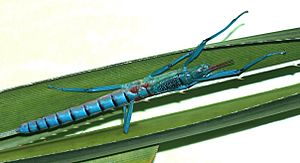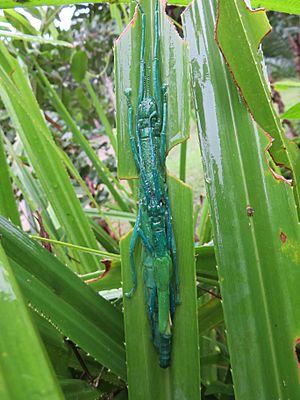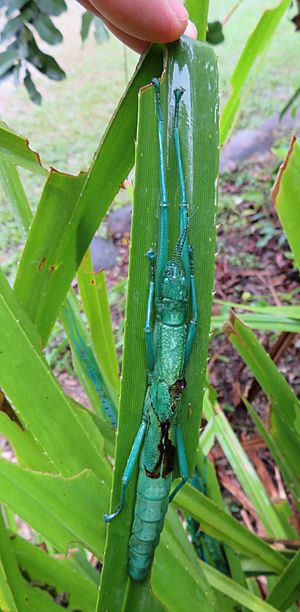Peppermint stick insect facts for kids
Quick facts for kids Peppermint stick insect |
|
|---|---|
 |
|
| Conservation status | |
| Scientific classification | |
| Synonyms | |
|
The Megacrania batesii, also known as the peppermint stick insect, is a very interesting type of stick insect. You can find it in places like northeastern Australia, the Solomon Islands, New Guinea, and possibly the Philippines. It's famous for its bright colors, which warn predators to stay away. It also has a strong way to defend itself using chemicals.
Its common name, "peppermint stick insect," comes from two things. First, it can spray a special liquid that smells like peppermint when it feels threatened. This liquid comes from two glands near its head. Second, its body is long and thin, just like a twig or a stick. This insect was first described by a naturalist named Henry Walter Bates in 1865.
These large insects live in special rainforests, usually where the forest meets the beach. They like to rest on the top of pandanus leaves, which they also eat. Some groups of these insects in northern Queensland are at risk of disappearing because of natural events or things people do.
Peppermint stick insects mostly reproduce by themselves, which is called parthenogenesis. But sometimes, they also reproduce with a partner. Spiders, centipedes, green tree ants, mantises, katydids, and some birds like to eat these insects. Also, a type of parasitoid wasp has been seen laying its eggs inside the eggs of the peppermint stick insect.
Contents
About the Peppermint Stick Insect
How it was Discovered
This species was first described by Henry Walter Bates in 1865. He gave it the name Platycrania alpheus. Later, in 1896, William Forsell Kirby reclassified it, giving it the name Megacrania batesii. It is one of twelve known species in the Megacrania group.
What They Look Like
Like most stick insects, the males are much smaller than the females. Male peppermint stick insects are about 76 to 87 millimeters long. Females are bigger, measuring about 98 to 137 millimeters. The parts of their body near the head are also smaller in males.
Both males and females have small front wings. But the males have larger back wings compared to their body size.
Adults and older young insects are mostly a pale green color. Their heads, bodies, and legs are a bit darker than their wings. Sometimes, their antennae, wing buds, and eyes can be different colors like yellow, red, or black.
Where They Live and Their Home
M. batesii lives in specific, spread-out areas in the Solomon Islands and New Guinea, and possibly the Philippines. There are also two separate groups of these insects in Australia: one in Queensland and another in the Gulf of Carpentaria.
They live in dense rainforests, usually right where the forest meets the beach. Here, they make their home in pandanus plants. Sometimes, they are found near rainforest streams or swamps, up to 5 kilometers inland.
Because these insects live in a very small and broken-up area (less than 100 square kilometers), they are considered a vulnerable species. Some groups in northern Queensland are at risk of disappearing due to natural events or human activities.
How They Behave and Live
These insects don't move around much. They usually rest on the top of pandanus leaves, which they eat. They stretch their front and middle legs forward and their back legs backward. They don't seem to use their back legs for walking.
Even though both male and female peppermint stick insects have wings, they cannot fly. However, the males, with their larger back wings, can "parachute" down to the forest floor if they feel threatened. They don't live in big groups; you'll rarely find more than three on one leaf cluster.
What They Eat and Who Eats Them
M. batesii eats three types of Pandanus plants in the wild: P. monticola, P. soloms-laubachii, and P. tectorius. You can tell if these stick insects have been around by the feeding marks they leave on the pandanus plants.
In captivity, they have been seen eating other plants like Freycinetia, P. gemmifer, P. utilis, and P. whitei.
Even though these insects can damage the plants they eat, they are not usually considered pests. This is because the pandanus plant is not very important for the economy. However, there was one report from the Philippines where an infestation of stick insects, possibly M. batesii, destroyed pandanus plants used to make mats.
Many animals like to eat the peppermint stick insect. These include huntsman spiders, jumping spiders, centipedes, green tree ants, mantises, katydids, and black butcherbirds. Also, tiny wasps called eupelmid wasps lay their eggs inside the eggs of M. batesii in Queensland.
Life Cycle and Reproduction
Most of the peppermint stick insects found in the wild are females. Males are not very common. In some groups, the main way they reproduce is through parthenogenesis. This means the females can lay eggs that hatch without needing a male. However, in other groups, and when they are kept in captivity, sexual reproduction (with a male and female) has also been seen.
How They Defend Themselves
There are about 2500 known types of stick insects. These large insects are often slow and clumsy, which makes them easy targets for predators. Most stick insects use crypsis to hide. This means they look like twigs and leaves to blend in with their surroundings. Only a few species have bright warning colors or special scent glands for defense.
The peppermint stick insect has both. It has warning colors, and it also has a strong chemical defense. If it feels very threatened, especially if its body is touched, it can spray a cloud of sticky, white fluid. This fluid comes from two glands located near its head.
An early description of a similar species mentioned that even young stick insects had a strong chemical defense. They could spray the fluid both in front of them and behind them. A female could spray as far as 75 centimeters, and even the smaller male could spray up to 50 centimeters.
These glands are like small pits on the sides of the insect's head area. When threatened, a muscle squeezes out a dome-shaped membrane through these pits. This membrane acts like a nozzle, spraying two jets of fluid. The insect can aim the spray forward or backward, depending on where the danger is coming from.
Other stick insect species also have a chemical defense where they secrete a noxious fluid from glands near their head. In most cases, the active chemicals in these secretions are called cyclopentanoid monoterpenes. A few exceptions exist, like Oreophoetes peruana and Phyllium westwoodii, which use different chemicals.
Some stick insects that use cyclopentanoid monoterpenes include several species from the Anisomorpha group. Other examples are Megacrania alpheus, Megacrania nigrosulfurea, and Megacrania tsudai. These are closely related to the peppermint stick insect and have a very similar chemical defense. The main chemical in their spray is called actinidine.
See also
 In Spanish: Insecto palo de menta piperita para niños
In Spanish: Insecto palo de menta piperita para niños




